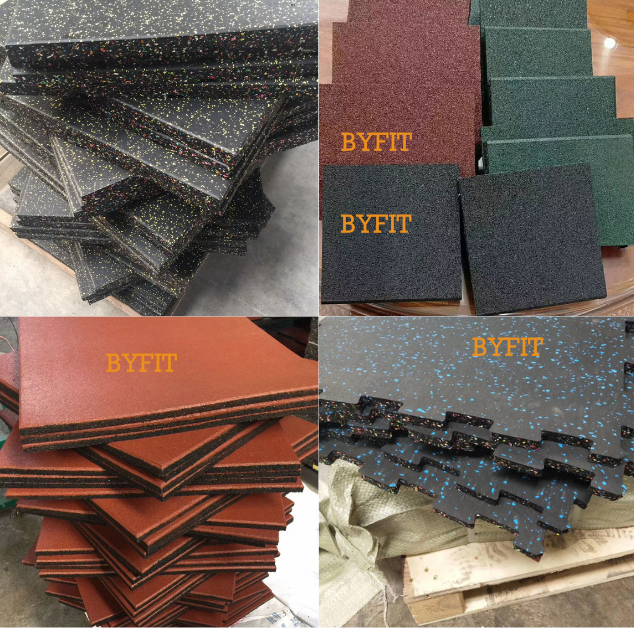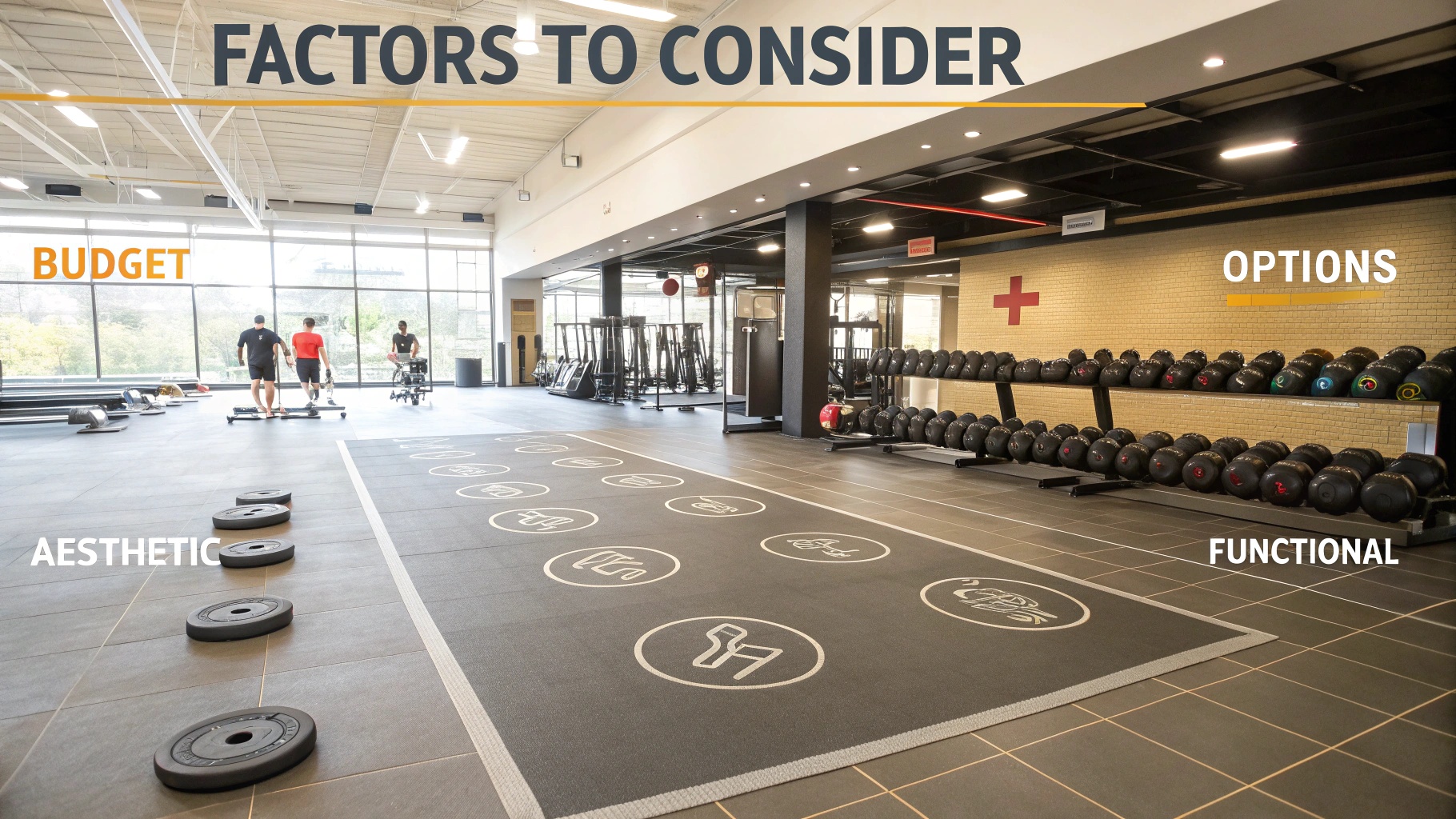Flooring is a pivotal choice for any gym—pick the wrong one, and you might end up with rapid wear, member complaints, or irreparable damage. What flooring truly stands out as ideal for a commercial gym?
High-density rubber flooring is best for commercial gyms. It’s durable, absorbs shock, and reduces noise. Eco-friendly rubber is popular because it’s recyclable.
](https://www.byfitgear.com/wp-content/uploads/2025/03/Commercial-Gym-Rubber-Flooring.jpg) BYFIT Commercial Gym Flooring – Durable and Eco-Friendly
BYFIT Commercial Gym Flooring – Durable and Eco-Friendly
Choosing gym flooring is overwhelming! But stay, I’ll make it easy, just like I did when I first started BYFIT. We’ll break it down.
What is the Best Flooring for a Commercial Gym?
Imagine walking into a gym, floor feels unsafe. Problem! Members might leave. So, what’s the solution?
For commercial gyms, high-density rubber flooring1 is best. It’s tough, absorbs impact, and reduces noise. This makes members happier.
![![BYFIT heavy-duty rubber flooring showcasing its ability to withstand extreme weight and pressure in industrial settings.,#placeholder_link]](https://www.byfitgear.com/wp-content/uploads/2025/03/89adb8df-c962-44b1-8297-a8cf7bba4363.jpeg) BYFIT High-Density Rubber Flooring – The Best Choice for Commercial Gyms
BYFIT High-Density Rubber Flooring – The Best Choice for Commercial Gyms
When I started BYFIT, I realized not all flooring is equal. High-density rubber stands out. Think of it like a bodyguard for your gym. Here’s why it works:
Why High-Density Rubber is Superior
| Feature | Benefit | Why It Matters |
|---|---|---|
| Durability | Withstands heavy weights and constant use | Longer lifespan, less replacement |
| Shock Absorption | Protects joints and reduces noise | Safer, quieter, comfortable workouts |
| Noise Reduction | Minimizes sound from dropped weights | Better environment, less disturbance |
| Easy to Clean | Simple maintenance, resists stains | Saves time and money, hygienic |
| Customizable | Various colors and thicknesses | Fits different areas and preferences |
The Rise of Eco-Friendly Options
Another trend is the increasing demand for eco-friendly rubber flooring2. Gym owners are looking for sustainability. Recycled rubber flooring helps reduce environmental impact.
BYFIT–Your Trusted Partner for Gym Rubber Flooring.
The Rise of Eco-Friendly Options
Another trend is the increasing demand for eco-friendly rubber flooring. Gym owners are looking for sustainability. Recycled rubber flooring helps reduce environmental impact.
BYFIT–Your Trusted Partner for Gym Rubber Flooring.
What is the Most Common Type of Gym Flooring?
Notice the flooring in gyms? Some areas need cushion, others need durability. It’s hard to find the balance.
Rubber flooring, rubber rolls, tiles, and mats, is popular. It’s durable, slip-resistant, and easy to maintain, for weight training, cardio, and training areas.
 BYFIT Rubber Tiles – The Most Common Gym Flooring Choice
BYFIT Rubber Tiles – The Most Common Gym Flooring Choice
Like choosing ingredients, selecting gym flooring is crucial. Rubber is versatile. Think of a friend’s kitchen – different surfaces. Rubber provides that for a gym. Types:
Comparing Different Rubber Flooring Types
| Flooring Type | Common Use | Advantages |
|---|---|---|
| Rubber Rolls3 | Large areas; heavy weightlifting | Seamless, durable, shock absorption |
| Rubber Tiles | Cardio zones, smaller spaces | Easy to install and replace, customizable |
| Interlocking Mats4 | Functional training, group exercise | Portable, quick setup, cushioning |
| Foam Tiles | Low Impact Activities. | Portable, quick setup, cushioning ,cheap |
| Vinyl Flooring | aerobic areas, dance studios, yoga rooms. | Easy maintenance, water resistance, designs |
| Turf Flooring | athletic training, agility training areas | Good performance, like natural grass |
Understanding Material Properties
Beyond the basic types, the material composition matters. Most gym rubber flooring is made from either virgin rubber or recycled rubber, or a blend. Virgin rubber offers, while recycled rubber provides a more, option.
BYFIT–Your Trusted Partner for Gym Rubber Flooring.
How Much Does Commercial Gym Flooring Cost?
Budgeting is tricky. Overspending might mean cutting corners. Under-spending could lead to poor quality. Where’s the balance?
Commercial gym flooring5 costs $20 and $80 per square meter. Depends on material, thickness, brand, and installation. Premium flooring costs more upfront but saves money.
](https://www.byfitgear.com/wp-content/uploads/2025/03/Gym-Floor-Cost.jpeg) BYFIT Commercial Gym Flooring Cost Comparison
BYFIT Commercial Gym Flooring Cost Comparison
Like buying a car – paying more means fewer repairs. When I set up BYFIT, I focused on value. Breakdown:
Factors Influencing Cost6
| Factor | Impact on Cost | Details |
|---|---|---|
| Material | Varies | Rubber is more expensive than foam |
| Thickness | Increases cost | Thicker flooring, better absorption |
| Brand | Varies | Premium brands, higher costs |
| Installation | Adds to cost | Professional installation ensures setup |
| Customization | Adds to cost | Custom logos or colors, increase expenses |
Long-Term Cost Considerations7
It’s also important to consider long-term costs. While the initial investment in higher-quality flooring might be greater, the reduced maintenance, repair, and replacement costs often make it a more economical choice in the long run.
BYFIT–Your Trusted Partner for Gym Rubber Flooring.
How Do I Choose Gym Flooring?
Choosing wrong can lead to problems. Like wearing wrong shoes – uncomfortable. So, how do you choose?
Consider durability, shock absorption, slip resistance, maintenance, and environment. High-density rubber flooring checks, choice.
 BYFIT Gym Flooring Selection Guide – Key Factors to Consider
BYFIT Gym Flooring Selection Guide – Key Factors to Consider
Like picking the right tool – you wouldn’t use a hammer to screw. From BYFIT, factors is key. Breakdown:
Key Considerations for Selection
| Factor | Why It’s Important | What to Look For |
|---|---|---|
| Durability | Ensures the floor lasts | High-density, wear resistance |
| Shock Absorption | Protects joints and reduces noise | Cushioning, impact reduction |
| Slip Resistance | Safety | Textured surfaces, non-slip |
| Ease of Maintenance | Keeps the gym clean | Waterproof, stain-resistant, easy-to-clean |
| Environmental Standards | Safe and sustainable | Low VOC, recyclable |
Matching Flooring to Gym Activities
Different areas of a gym have different flooring needs. Consider these matches:
- Weightlifting Areas: Thick rubber mats or rolled rubber.
- Cardio Zones: Thinner rubber or vinyl flooring.
- Functional Training Areas: Interlocking rubber tiles or turf.
BYFIT–Your Trusted Partner for Gym Rubber Flooring.
How Do I Choose Gym Flooring?
Choosing wrong can lead to problems. Like wearing wrong shoes – uncomfortable. So, how do you choose?
Consider durability8, shock absorption, slip resistance, maintenance, and environment. High-density rubber flooring checks, choice.
 BYFIT Gym Flooring Selection Guide – Key Factors to Consider
BYFIT Gym Flooring Selection Guide – Key Factors to Consider
Like picking the right tool – you wouldn’t use a hammer to screw. From BYFIT, factors is key. Breakdown:
Key Considerations for Selection
| Factor | Why It’s Important | What to Look For |
|---|---|---|
| Durability | Ensures the floor lasts | High-density, wear resistance |
| Shock Absorption | Protects joints and reduces noise | Cushioning, impact reduction |
| Slip Resistance | Safety | Textured surfaces, non-slip |
| Ease of Maintenance | Keeps the gym clean | Waterproof, stain-resistant, easy-to-clean |
| Environmental Standards | Safe and sustainable | Low VOC, recyclable |
Matching Flooring to Gym Activities
Different areas of a gym have different flooring needs. Consider these matches:
- Weightlifting Areas: Thick rubber mats or rolled rubber.
- Cardio Zones: Thinner rubber or vinyl flooring.
- Functional Training Areas: Interlocking rubber tiles or turf.
BYFIT–Your Trusted Partner for Gym Rubber Flooring.
Conclusion
Selecting the ideal flooring for your gym demands a meticulous balance between several critical factors: durability to withstand heavy traffic and repetitive impact, safety to protect users from slips or injuries, cost-effectiveness to align with budget constraints, and compliance with industry standards for things like fire resistance or slip resistance. Among the many options available, high-density rubber flooring has emerged as the go-to solution for most commercial gyms. Its dense composition offers exceptional shock absorption for equipment like dumbbells or treadmills, resistance to indentation from heavy weights, and a non-slip surface that lowers fall risks. Plus, its long lifespan and low maintenance requirements offset initial costs over time, making it an investment rather than an expense. It’s also readily customizable with anti-microbial coatings or seamless welding to meet hygiene and safety regulations. Ready to explore how high-density rubber can address all these priorities in your space?
-
Explore the advantages of high-density rubber flooring, which is essential for safety and comfort in commercial gyms. ↩
-
Discover how eco-friendly rubber flooring can enhance sustainability in your gym while providing excellent performance. ↩
-
Learn about the seamless and shock-absorbing qualities of rubber rolls, ideal for heavy weightlifting areas in gyms. ↩
-
Discover the portability and quick setup of interlocking mats, perfect for functional training and group exercises. ↩
-
Explore this link to discover various types of commercial gym flooring, their benefits, and how to choose the right one for your needs. ↩
-
Understanding these factors can help you make informed decisions and budget effectively for your gym flooring project. ↩
-
This resource will provide insights into how initial investments can lead to savings over time, making it essential for budget planning. ↩
-
Learning about durability helps you invest in flooring that lasts, saving money and maintenance in the long run. ↩

](https://www.byfitgear.com/wp-content/uploads/2025/03/Clean-and-Aesthetic-BYFIT-Gym-Rubber-Flooring.jpg)

